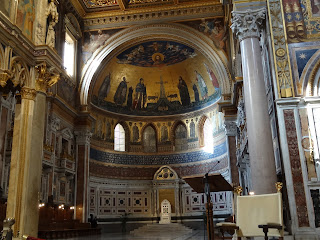On Sunday, April 7, Pope Francis visited the Basilica of St.
John Lateran for the first time and was officially “enthroned” on the chair –
the cathedra – of the diocese of
Rome.
The basilica was originally and officially called the
Archbasilica of our most holy Savior, and later dedicated to St. John the
Baptist and also St. John the Evangleilst. The church and the palace were first
on land given by Constantine. It has been rebuilt and restored several times.
the popes lived there until the 14th century.
I visited the basilica in February this year and found it a
much more prayerful place than St. Peter’s. It helped that I arrived just in
time for a Sunday morning Mass.
Though St. Francis would not have seen any of the present
buildings he is present in art and in the history in and around the basilica.
About 1209, Francis went to Rome, probably with all his
first followers, to get permission from the pope to continue their way of life
based on the Gospels.
The pope, according to some accounts, had a dream in which
the Lateran Basilica was falling down and a brother was holding it up. When
Francis appeared, the pope recognized Francis as this man and verbally approved
their way of life.
As Benedict XVI once said:
In [Pope Innocent III’s dream], he saw the Basilica of St John Lateran, the mother of all churches, collapsing and one small and insignificant religious brother supporting the church on his shoulders to prevent it from falling. On the one hand, it is interesting to note that it is not the Pope who was helping to prevent the church from collapsing but rather a small and insignificant brother, whom the Pope recognized in Francis when he later came to visit.
And so in the mosaic in the apse of the basilica you can see
a small image of St. Francis.
But what really moved me is the sculpture of Francis and his
companions which faces the Lateran. Erected about 1925 to celebrate the
anniversary of Francis’ death (in 1226) it is often said to be Francis
embracing the Lateran and offering homage to the mother of all churches, and
acknowledging the authority of the pope, whose authorization he had come
seeking.
Yet when I saw it in February I could not help thinking that
it represented a subtle plea of Francis before the pomp and finery of the Roman
Church of his day (and ours) to change.
Francis was not a vocal critic of the opulence of the
Papacy, though I wonder what he really thought. For, I believe, that his life
and his example, and the rule he had written based on the Gospels are unspoken
critiques.
Francis respected the pope and all priests; he not only
rebuilt fallen-down churches but he insisted that churches be clean and the
vessels and altar cloths be worthy of the God who became human in Jesus and is
present in the Eucharist.
But the opulence of the popes of his day was so much in contrast
with his desire to be with the marginalized, the powerless, the poor of his
day.
And so today, as Pope Francis sits on the bishop of Rome’s
chair, I pray that he vision of “a poor Church, a Church for the poor,” may become
a reality as “a Church of the poor.” where the poor have a privileged place and
where we begin to see the world from the perspective of Christ who became poor
for our sake and preached “Good News for the Poor.”




No comments:
Post a Comment